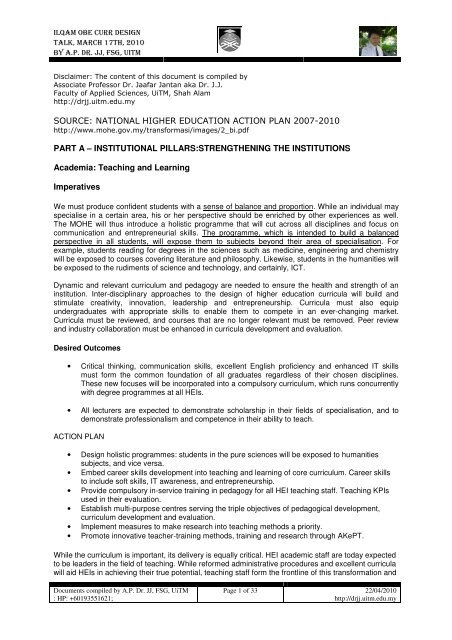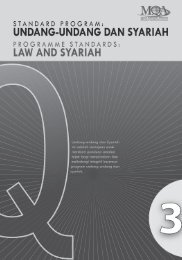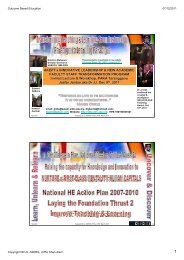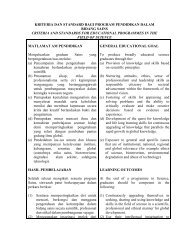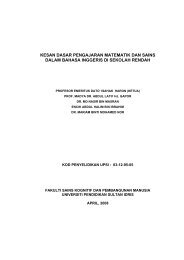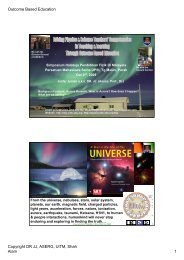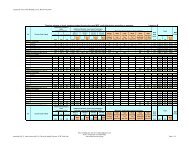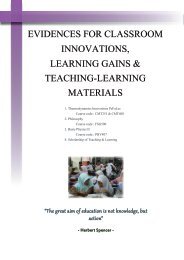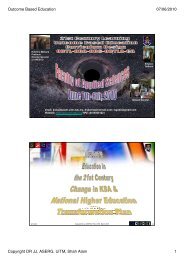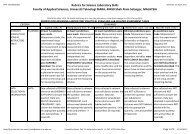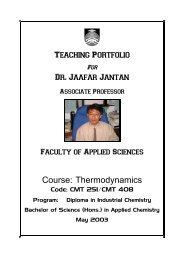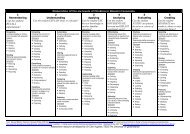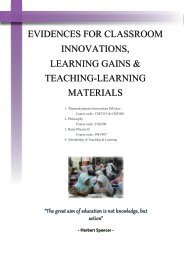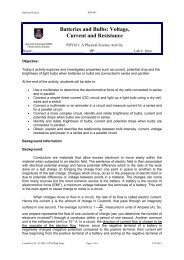Bloom's & Solo - DrJJ - UiTM
Bloom's & Solo - DrJJ - UiTM
Bloom's & Solo - DrJJ - UiTM
Create successful ePaper yourself
Turn your PDF publications into a flip-book with our unique Google optimized e-Paper software.
ILQAM OBE CURR DESIGN<br />
TALK, MARCH 17TH, 2010<br />
BY A.P. DR. JJ, FSG, UITM<br />
Disclaimer: The content of this document is compiled by<br />
Associate Professor Dr. Jaafar Jantan aka Dr. J.J.<br />
Faculty of Applied Sciences, <strong>UiTM</strong>, Shah Alam<br />
http://drjj.uitm.edu.my<br />
SOURCE: NATIONAL HIGHER EDUCATION ACTION PLAN 2007-2010<br />
http://www.mohe.gov.my/transformasi/images/2_bi.pdf<br />
PART A – INSTITUTIONAL PILLARS:STRENGTHENING THE INSTITUTIONS<br />
Academia: Teaching and Learning<br />
Imperatives<br />
We must produce confident students with a sense of balance and proportion. While an individual may<br />
specialise in a certain area, his or her perspective should be enriched by other experiences as well.<br />
The MOHE will thus introduce a holistic programme that will cut across all disciplines and focus on<br />
communication and entrepreneurial skills. The programme, which is intended to build a balanced<br />
perspective in all students, will expose them to subjects beyond their area of specialisation. For<br />
example, students reading for degrees in the sciences such as medicine, engineering and chemistry<br />
will be exposed to courses covering literature and philosophy. Likewise, students in the humanities will<br />
be exposed to the rudiments of science and technology, and certainly, ICT.<br />
Dynamic and relevant curriculum and pedagogy are needed to ensure the health and strength of an<br />
institution. Inter-disciplinary approaches to the design of higher education curricula will build and<br />
stimulate creativity, innovation, leadership and entrepreneurship. Curricula must also equip<br />
undergraduates with appropriate skills to enable them to compete in an ever-changing market.<br />
Curricula must be reviewed, and courses that are no longer relevant must be removed. Peer review<br />
and industry collaboration must be enhanced in curricula development and evaluation.<br />
Desired Outcomes<br />
• Critical thinking, communication skills, excellent English proficiency and enhanced IT skills<br />
must form the common foundation of all graduates regardless of their chosen disciplines.<br />
These new focuses will be incorporated into a compulsory curriculum, which runs concurrently<br />
with degree programmes at all HEIs.<br />
• All lecturers are expected to demonstrate scholarship in their fields of specialisation, and to<br />
demonstrate professionalism and competence in their ability to teach.<br />
ACTION PLAN<br />
• Design holistic programmes: students in the pure sciences will be exposed to humanities<br />
subjects, and vice versa.<br />
• Embed career skills development into teaching and learning of core curriculum. Career skills<br />
to include soft skills, IT awareness, and entrepreneurship.<br />
• Provide compulsory in-service training in pedagogy for all HEI teaching staff. Teaching KPIs<br />
used in their evaluation.<br />
• Establish multi-purpose centres serving the triple objectives of pedagogical development,<br />
curriculum development and evaluation.<br />
• Implement measures to make research into teaching methods a priority.<br />
• Promote innovative teacher-training methods, training and research through AKePT.<br />
While the curriculum is important, its delivery is equally critical. HEI academic staff are today expected<br />
to be leaders in the field of teaching. While reformed administrative procedures and excellent curricula<br />
will aid HEIs in achieving their true potential, teaching staff form the frontline of this transformation and<br />
Documents compiled by A.P. Dr. JJ, FSG, <strong>UiTM</strong><br />
: HP: +60193551621;<br />
Page 1 of 33 22/04/2010<br />
http://drjj.uitm.edu.my
TALK, MARCH 17TH, 2010<br />
BY A.P. DR. JJ, FSG, UITM<br />
¡¢£¤¥¦§¨©§<br />
must focus on innovative delivery of curricula. Adoption of innovative modes such as active learning or<br />
problem-based learning will be encouraged where appropriate to promote the development of<br />
communication, problem-solving, and self-directed learning skills.<br />
Evaluation is an important aspect of pedagogy, the skills of which must be acquired by all academic<br />
staff. Good teaching must be followed by good evaluation. The aim of evaluation is to obtain<br />
information regarding the level of mastery of a subject that the student has learned and grasped.<br />
A policy will be formulated to encourage the acquisition and demonstration of teaching skills for all HEI<br />
academic staff. As a first step, the MOHE will draw up in-service programmes for university lecturers<br />
and professors to undergo enrichment programmes in the science and methodology of pedagogy.<br />
Documents compiled by A.P. Dr. JJ, FSG, <strong>UiTM</strong><br />
: HP: +60193551621;<br />
Page 2 of 33 22/04/2010<br />
http://drjj.uitm.edu.my
BY A.P. DR. JJ, FSG, UITM<br />
£¡¤£¨<br />
<br />
Understanding by Design by Grant Wiggins and Jay McTighe<br />
¡¢£¤¥¦§¨©§<br />
Backward Design<br />
Why “backward” is best<br />
Deliberate and focused instructional design requires us as teachers and curriculum writers to make an<br />
important shift in our thinking about the nature of our job. The shift involves thinking a great deal,<br />
first, about the specific learnings sought, and the evidence of such learnings, before thinking about<br />
what we, as the teacher, will do or provide in teaching and learning activities. Though considerations<br />
about what to teach and how to teach it may dominate our thinking as a matter of habit, the challenge<br />
is to focus first on the desired learnings from which appropriate teaching will logically follow.<br />
Our lessons, units, and courses should be logically inferred from the results sought, not derived from<br />
the methods, books, and activities with which we are most comfortable. Curriculum should lay out the<br />
most effective ways of achieving specific results. It is analogous to travel planning. Our frameworks<br />
should provide a set of itineraries deliberately designed to meet cultural goals rather than a purposeless<br />
tour of all the major sites in a foreign country. In short, the best designs derive backward from the<br />
learnings sought.<br />
The appropriateness of this approach becomes clearer when we consider the educational purpose that<br />
is the focus of this book: understanding. We cannot say how to teach for understanding or which<br />
material and activities to use until we are quite clear about which specific understandings we are after<br />
and what such understandings look like in practice. We can best decide, as guides, what “sites” to have<br />
our student “tourists” visit and what specific “culture” they should experience in their brief time there<br />
only if we are clear about the particular understandings about the culture we want them to take home.<br />
Only by having specified the desired results can we focus on the content, methods, and activities most<br />
likely to achieve those results.<br />
But many teachers begin with and remain focused on textbooks, favored lessons, and time-honored<br />
activities—the inputs—rather than deriving those means from what is implied in the desired results—<br />
the output. To put it in an odd way, too many teachers focus on the teaching and not the learning.<br />
They spend most of their time thinking, first, about what they will do, what materials they will use,<br />
and what they will ask students to do rather than first considering what the learner will need in order to<br />
accomplish the learning goals.<br />
Consider a typical episode of what might be called content-focused design instead of results-focused<br />
design. The teacher might base a lesson on a particular topic (e.g., racial prejudice), select a resource<br />
(e.g., To Kill a Mockingbird), choose specific instructional methods based on the resource and topic<br />
(e.g., Socratic seminar to discuss the book and cooperative groups to analyze stereotypical images in<br />
films and on television), and hope thereby to cause learning (and meet a few English/language arts<br />
standards). Finally, the teacher might think up a few essay questions and quizzes for assessing student<br />
understanding of the book.<br />
This approach is so common that we may well be tempted to reply, What could be wrong with such an<br />
approach The short answer lies in the basic questions of purpose: Why are we asking students to read<br />
this particular novel—in other words, what learnings will we seek from their having read it Do the<br />
students grasp why and how the purpose should influence their studying What should students be<br />
expected to understand and do upon reading the book, related to our goals beyond the book Unless<br />
Documents compiled by A.P. Dr. JJ, FSG, <strong>UiTM</strong><br />
: HP: +60193551621;<br />
Page 3 of 33 22/04/2010<br />
http://drjj.uitm.edu.my
we begin our design work with a clear insight into larger purposes—whereby the book is properly<br />
thought of as a means to an educational end, not an end unto itself—it is unlikely that all students will<br />
understand the book (and their performance obligations). Without being self-conscious of the specific<br />
understandings about prejudice we seek, and how reading and discussing the book will help develop<br />
such insights, the goal is far too vague: The approach is more “by hope” than “by design.” Such an<br />
approach ends up unwittingly being one that could be described like this: Throw some content and<br />
activities against the wall and hope some of it sticks.<br />
£¡¤£¨ ¦£© ¤ ¡¢£¤¥¦§¨©§<br />
Answering the “why” and “so what” questions that older students always ask (or want to), and doing<br />
so in concrete terms as the focus of curriculum planning, is thus the essence of understanding by<br />
design. What is difficult for many teachers to see (but easier for students to feel!) is that, without such<br />
explicit and transparent priorities, many students find day-to-day work confusing and frustrating.<br />
The twin sins of traditional design<br />
More generally, weak educational design involves two kinds of purposelessness, visible throughout the<br />
educational world from kindergarten through graduate school. We call these the “twin sins” of<br />
traditional design. The error of activity-oriented design might be called “hands-on without being<br />
minds-on”—engaging experiences that lead only accidentally, if at all, to insight or achievement. The<br />
activities, though fun and interesting, do not lead anywhere intellectually. Such activity-oriented<br />
curricula lack an explicit focus on important ideas and appropriate evidence of learning, especially in<br />
the minds of the learners.<br />
A second form of aimlessness goes by the name of “coverage,” an approach in which students march<br />
through a textbook, page by page (or teachers through lecture notes) in a valiant attempt to traverse all<br />
the factual material within a prescribed time. Coverage is thus like a whirlwind tour of Europe,<br />
perfectly summarized by the old movie title If It's Tuesday, This Must Be Belgium, which properly<br />
suggests that no overarching goals inform the tour.<br />
As a broad generalization, the activity focus is more typical at the elementary and lower middle school<br />
levels, whereas coverage is a prevalent secondary school and college problem. No guiding intellectual<br />
purpose or clear priorities frame the learning experience. In neither case can students see and answer<br />
such questions as these: What's the point What's the big idea here What does this help us understand<br />
or be able to do To what does this relate Why should we learn this Hence, the students try to<br />
engage and follow as best they can, hoping that meaning will emerge.<br />
The three stages of backward design<br />
Stage 1: Identify desired results<br />
What should students know, understand, and be able to do What content is worthy of understanding<br />
What enduring understandings are desired In Stage 1 we consider our goals, examine established<br />
content standards (national, state, district), and review curriculum expectations. Because typically we<br />
have more content than we can reasonably address within the available time, we must make choices.<br />
This first stage in the design process calls for clarity about priorities.<br />
Documents compiled by A.P. Dr. JJ, FSG, <strong>UiTM</strong><br />
: HP: +60193551621;<br />
Page 4 of 33 22/04/2010<br />
http://drjj.uitm.edu.my
Stage 2: Determine acceptable evidence<br />
How will we know if students have achieved the desired results What will we accept as evidence of<br />
student understanding and proficiency The backward design orientation suggests that we think about<br />
a unit or course in terms of the collected assessment evidence needed to document and validate that the<br />
desired learning has been achieved, not simply as content to be covered or as a series of learning<br />
activities. This approach encourages teachers and curriculum planners to first “think like an assessor”<br />
before designing specific units and lessons, and thus to consider up front how they will determine if<br />
students have attained the desired understandings.<br />
£¡¤£¨ ¦£© ¤ ¡¢£¤¥¦§¨©§<br />
Stage 3: Plan learning experiences and instruction<br />
With clearly identified results and appropriate evidence of understanding in mind, it is now the time to<br />
fully think through the most appropriate instructional activities. Several key questions must be<br />
considered at this stage of backward design: What enabling knowledge (facts, concepts, principles)<br />
and skills (processes, procedures, strategies) will students need in order to perform effectively and<br />
achieve desired results What activities will equip students with the needed knowledge and skills<br />
What will need to be taught and coached, and how should it best be taught, in light of performance<br />
goals What materials and resources are best suited to accomplish these goals<br />
Note that the specifics of instructional planning—choices about teaching methods, sequence of<br />
lessons, and resource materials—can be successfully completed only after we identify desired results<br />
and assessments and consider what they imply. Teaching is a means to an end. Having a clear goal<br />
helps to focus our planning and guide purposeful action toward the intended results.<br />
Conclusion<br />
Backward design may be thought of, in other words, as purposeful task analysis: Given a worthy task<br />
to be accomplished, how do we best get everyone equipped Or we might think of it as building a wise<br />
itinerary, using a map: Given a destination, what's the most effective and efficient route Or we might<br />
think of it as planning for coaching: What must learners master if they are to effectively perform<br />
What will count as evidence on the field, not merely in drills, that they really get it and are ready to<br />
perform with understanding, knowledge, and skill on their own How will the learning be designed so<br />
that learners' capacities are developed through use and feedback<br />
This is all quite logical when you come to understand it, but “backward” from the perspective of much<br />
habit and tradition in our field. A major change from common practice occurs as designers must begin<br />
to think about assessment before deciding what and how they will teach. Rather than creating<br />
assessments near the conclusion of a unit of study (or relying on the tests provided by textbook<br />
publishers, which may not completely or appropriately assess our standards and goals), backward<br />
design calls for us to make our goals or standards specific and concrete, in terms of assessment<br />
evidence, as we begin to plan a unit or course.<br />
The rubber meets the road with assessment. Three different teachers may all be working toward the<br />
same content standards, but if their assessments vary considerably, how are we to know which<br />
students have achieved what Agreement on needed evidence of learning leads to greater curricular<br />
coherence and more reliable evaluation by teachers. Equally important is the long-term gain in teacher,<br />
student, and parent insight about what does and does not count as evidence of meeting complex<br />
standards.<br />
Documents compiled by A.P. Dr. JJ, FSG, <strong>UiTM</strong><br />
: HP: +60193551621;<br />
Page 5 of 33 22/04/2010<br />
http://drjj.uitm.edu.my
£¡¤£¨ ¡¢£¤¥¦§¨©§<br />
¤<br />
Home http://www.fctel.uncc.edu/index.html<br />
¦£©<br />
Writing Objectives Using Bloom’s Taxonomy<br />
Various researchers have summarized how to use Bloom’s Taxonomy. Following are four<br />
interpretations that you can use as guides in helping to write objectives using Bloom’s<br />
Taxonomy.<br />
From: http://www.kcmetro.cc.mo.us/longview/ctac/blooms.htm<br />
Bloom’s Taxonomy divides the way people learn into three domains. One of these is the<br />
cognitive domain, which emphasizes intellectual outcomes. This domain is further divided<br />
into categories or levels. The key words used and the type of questions asked may aid in the<br />
establishment and encouragement of critical thinking, especially in the higher levels.<br />
Level Level Attributes Keywords Questions<br />
1: Knowledge Exhibits previously<br />
learned material by<br />
recalling facts,<br />
terms, basic<br />
concepts and<br />
answers.<br />
who, what, why, when,<br />
omit, where, which,<br />
choose, find, how,<br />
define, label, show,<br />
spell, list, match, name,<br />
relate, tell, recall, select<br />
What is ... How is ...<br />
Where is ... When did<br />
_______ happen How<br />
did ______ happen How<br />
would you explain ...<br />
Why did ... How would<br />
you describe ... When<br />
did ... Can you recall ...<br />
How would you show ...<br />
Can you select ... Who<br />
were the main ... Can<br />
you list three ... Which<br />
one ... Who was ...<br />
2: Comprehension Demonstrating<br />
understanding of<br />
facts and ideas by<br />
organizing,<br />
comparing,<br />
translating,<br />
interpreting, giving<br />
descriptions and<br />
stating main ideas.<br />
compare, contrast,<br />
demonstrate, interpret,<br />
explain, extend,<br />
illustrate, infer, outline,<br />
relate, rephrase,<br />
translate, summarize,<br />
show, classify<br />
How would you classify<br />
the type of ... How would<br />
you compare ... contrast<br />
... Will you state or<br />
interpret in your own<br />
words ... How would you<br />
rephrase the meaning ...<br />
What facts or ideas show<br />
... What is the main idea<br />
of ... Which statements<br />
support ... Can you<br />
explain what is happening<br />
. . . what is meant . . .<br />
Documents compiled by A.P. Dr. JJ, FSG, <strong>UiTM</strong><br />
: HP: +60193551621;<br />
Page 6 of 33 22/04/2010<br />
http://drjj.uitm.edu.my
Level Level Attributes Keywords Questions<br />
£¡¤£¨ ¦£© ¤ ¡¢£¤¥¦§¨©§<br />
What can you say about<br />
... Which is the best<br />
answer ... How would<br />
you summarize ...<br />
3: Application Solving problems by apply, build, choose,<br />
applying acquired construct, develop,<br />
knowledge, facts, interview, make use of,<br />
techniques and rules organize, experiment<br />
in a different way. with, plan, select, solve,<br />
utilize, model, identify<br />
How would you use ...<br />
What examples can you<br />
find to ... How would you<br />
solve _______ using what<br />
you have learned ... How<br />
would you organize<br />
_______ to show ... How<br />
would you show your<br />
understanding of ...<br />
What approach would you<br />
use to ... How would you<br />
apply what you learned to<br />
develop ... What other<br />
way would you plan to ...<br />
What would result if ...<br />
Can you make use of the<br />
facts to ... What<br />
elements would you<br />
choose to change ...<br />
What facts would you<br />
select to show ... What<br />
questions would you ask<br />
in an interview with ...<br />
4: Analysis Examining and<br />
breaking information<br />
into parts by<br />
identifying motives<br />
or causes; making<br />
inferences and<br />
finding evidence to<br />
support<br />
generalizations.<br />
analyze, categorize,<br />
classify, compare,<br />
contrast, discover,<br />
dissect, divide, examine,<br />
inspect, simplify, survey,<br />
take part in, test for,<br />
distinguish, list,<br />
distinction, theme,<br />
relationships, function,<br />
motive, inference,<br />
assumption, conclusion<br />
What are the parts or<br />
features of ... How is<br />
_______ related to ...<br />
Why do you think ...<br />
What is the theme ...<br />
What motive is there ...<br />
Can you list the parts ...<br />
What inference can you<br />
make ... What<br />
conclusions can you draw<br />
... How would you<br />
classify ... How would<br />
you categorize ... Can<br />
you identify the difference<br />
parts ... What evidence<br />
can you find ... What is<br />
the relationship between<br />
... Can you make a<br />
distinction between ...<br />
What is the function of ...<br />
Documents compiled by A.P. Dr. JJ, FSG, <strong>UiTM</strong><br />
: HP: +60193551621;<br />
Page 7 of 33 22/04/2010<br />
http://drjj.uitm.edu.my
Level Level Attributes Keywords Questions<br />
£¡¤£¨ ¦£© ¤ ¡¢£¤¥¦§¨©§<br />
What ideas justify ...<br />
5: Synthesis Compiling<br />
information together<br />
in a different way by<br />
combining elements<br />
in a new pattern or<br />
proposing<br />
alternative solutions.<br />
6: Evaluation Presenting and<br />
defending opinions<br />
by making<br />
judgments about<br />
information, validity<br />
of ideas or quality of<br />
work based on a set<br />
of criteria.<br />
build, choose, combine,<br />
compile, compose,<br />
construct, create,<br />
design, develop,<br />
estimate, formulate,<br />
imagine, invent, make<br />
up, originate, plan,<br />
predict, propose, solve,<br />
solution, suppose,<br />
discuss, modify, change,<br />
original, improve, adapt,<br />
minimize, maximize,<br />
delete, theorize,<br />
elaborate, test, improve,<br />
happen, change<br />
award, choose,<br />
conclude, criticize,<br />
decide, defend,<br />
determine, dispute,<br />
evaluate, judge, justify,<br />
measure, compare,<br />
mark, rate, recommend,<br />
rule on, select, agree,<br />
interpret, explain,<br />
appraise, prioritize,<br />
opinion, ,support,<br />
importance, criteria,<br />
prove, disprove, assess,<br />
influence, perceive,<br />
What changes would you<br />
make to solve ... How<br />
would you improve ...<br />
What would happen if ...<br />
Can you elaborate on the<br />
reason ... Can you<br />
propose an alternative ...<br />
Can you invent ... How<br />
would you adapt<br />
________ to create a<br />
different ... How could<br />
you change (modify) the<br />
plot (plan) ... What could<br />
be done to minimize<br />
(maximize) ... What way<br />
would you design ...<br />
What could be combined<br />
to improve (change) ...<br />
Suppose you could<br />
_______ what would you<br />
do ... How would you<br />
test ... Can you<br />
formulate a theory for ...<br />
Can you predict the<br />
outcome if ... How would<br />
you estimate the results<br />
for ... What facts can you<br />
compile ... Can you<br />
construct a model that<br />
would change ... Can<br />
you think of an original<br />
way for the ...<br />
Do you agree with the<br />
actions ... with the<br />
outcomes ... What is<br />
your opinion of ... How<br />
would you prove ...<br />
disprove ... Can you<br />
assess the value or<br />
importance of ... Would it<br />
be better if ... Why did<br />
they (the character)<br />
choose ... What would<br />
you recommend ... How<br />
would you rate the ...<br />
What would you cite to<br />
Documents compiled by A.P. Dr. JJ, FSG, <strong>UiTM</strong><br />
: HP: +60193551621;<br />
Page 8 of 33 22/04/2010<br />
http://drjj.uitm.edu.my
Level Level Attributes Keywords Questions<br />
£¡¤£¨ ¦£© ¤ ¡¢£¤¥¦§¨©§<br />
value, estimate,<br />
influence, deduct<br />
defend the actions ...<br />
How would you evaluate<br />
... How could you<br />
determine ... What<br />
choice would you have<br />
made ... What would you<br />
select ... How would you<br />
prioritize ... What<br />
judgment would you make<br />
about ... Based on what<br />
you know, how would you<br />
explain ... What<br />
information would you use<br />
to support the view ...<br />
How would you justify ...<br />
What data was used to<br />
make the conclusion ...<br />
Why was it better that ...<br />
How would you prioritize<br />
the facts ... How would<br />
you compare the ideas<br />
... people ...<br />
From: http://www.umuc.edu/ugp/ewp/bloomtax.html<br />
Bloom’s Ranking of Thinking Skills<br />
Knowledge Comprehension Application Analysis Synthesis Evaluation<br />
List, Name,<br />
Identify,<br />
Show,<br />
Define,<br />
Recognize,<br />
Recall, State,<br />
Visualize<br />
Summarize,<br />
Explain, Interpret,<br />
Describe,<br />
Compare,<br />
Paraphrase,<br />
Differentiate,<br />
Demonstrate,<br />
Classify<br />
Solve,<br />
Illustrate,<br />
Calculate,<br />
Use,<br />
Interpret,<br />
Relate,<br />
Manipulate,<br />
Apply, Modify<br />
Analyze,<br />
Organize,<br />
Deduce,<br />
Contrast,<br />
Compare,<br />
Distinguish,<br />
Discuss,<br />
Plan, Devise<br />
Design,<br />
Hypothesize,<br />
Support,<br />
Schematize,<br />
Write, Report,<br />
Justify<br />
Evaluate,<br />
Choose,<br />
Estimate,<br />
Judge,<br />
Defend,<br />
Criticize<br />
From: http://www.stedwards.edu/cte/bwheel.htm<br />
Documents compiled by A.P. Dr. JJ, FSG, <strong>UiTM</strong><br />
: HP: +60193551621;<br />
Page 9 of 33 22/04/2010<br />
http://drjj.uitm.edu.my
Task Oriented Question Construction Wheel Based on Bloom’s Taxonomy<br />
£¡¤£¨ ¦£© ¤ ¡¢£¤¥¦§¨©§<br />
Task Oriented Question Construction Wheel Based on Bloom’s Taxonomy.<br />
©2001 St. Edward’s University Center for Teaching Excellence.<br />
http://www.stedwards.edu/cte/bwheel.htm<br />
From: http://epitome.ce.gatech.edu/iowa/how.html<br />
According to Benjamin Bloom, and his colleagues, there are six levels of cognition:<br />
1. Knowledge: rote memorization, recognition, or recall of facts<br />
2. Comprehension: understanding what the facts mean<br />
3. Application: correct use of the facts, rules, or ideas<br />
4. Analysis: breaking down information into component parts<br />
5. Synthesis: combination of facts, ideas, or information to make a new whole<br />
6. Evaluation: judging or forming an opinion about the information or situation<br />
Ideally, each of these levels should be covered in each course and, thus, at least one<br />
objective should be written for each level. Depending on the nature of the course, a few of<br />
these levels may need to be given more emphasis than the others.<br />
Documents compiled by A.P. Dr. JJ, FSG, <strong>UiTM</strong><br />
: HP: +60193551621;<br />
Page 10 of 33 22/04/2010<br />
http://drjj.uitm.edu.my
Below are examples of objectives written for each level of Bloom’s Taxonomy and activities<br />
and assessment tools based on those objectives. Common key verbs used in drafting<br />
objectives are also listed for each level.<br />
£¡¤£¨ ¦£© ¤ ¡¢£¤¥¦§¨©§<br />
Level<br />
Level<br />
Attributes<br />
Keywords<br />
Example<br />
Objective<br />
Example<br />
Activity<br />
Example<br />
Assessment<br />
1: Knowledge Rote<br />
memorization,<br />
recognition, or<br />
recall of facts.<br />
list, recite,<br />
define, name,<br />
match, quote,<br />
recall,<br />
identify, label,<br />
recognize<br />
“By the end of<br />
this course,<br />
the student<br />
will be able to<br />
recite<br />
Newton’s<br />
three laws of<br />
motion.”<br />
Have students<br />
group up and<br />
perform<br />
simple<br />
experiments<br />
to the class<br />
showing how<br />
one of the<br />
laws of motion<br />
works.<br />
Use the<br />
following<br />
question on an<br />
exam or<br />
homework.<br />
“Recite<br />
Newton’s<br />
three laws of<br />
motion.”<br />
2:<br />
Understanding<br />
Comprehension what the facts<br />
mean.<br />
describe,<br />
explain,<br />
paraphrase,<br />
restate, give<br />
original<br />
examples of,<br />
summarize,<br />
interpret,<br />
discuss<br />
“By the end of<br />
this course,<br />
the student<br />
will be able to<br />
explain<br />
Newton’s<br />
three laws of<br />
motion in<br />
his/her own<br />
words.”<br />
Group<br />
students into<br />
pairs and<br />
have each<br />
pair think of<br />
words that<br />
describe<br />
motion. After<br />
a few minutes,<br />
ask pairs to<br />
volunteer<br />
some of their<br />
descriptions<br />
and write<br />
these<br />
descriptions<br />
on the board.<br />
Assign the<br />
students to<br />
write a simple<br />
essay that<br />
explains what<br />
Newton’s laws<br />
of motion<br />
mean in<br />
his/her own<br />
words.<br />
3: Application Correct use of<br />
the facts,<br />
rules, or ideas.<br />
calculate,<br />
predict, apply,<br />
solve,<br />
illustrate, use,<br />
demonstrate,<br />
determine,<br />
model<br />
“By the end of<br />
this course,<br />
the student<br />
will be able to<br />
calculate the<br />
kinetic energy<br />
of a<br />
projectile.”<br />
After<br />
presenting the<br />
kinetic energy<br />
equation in<br />
class, have<br />
the students<br />
pair off for just<br />
a few minutes<br />
and practice<br />
using it so that<br />
they feel<br />
comfortable<br />
with it before<br />
being<br />
On a test,<br />
define a<br />
projectile and<br />
ask the<br />
students to<br />
“Calculate the<br />
kinetic energy<br />
of the<br />
projectile.”<br />
Documents compiled by A.P. Dr. JJ, FSG, <strong>UiTM</strong><br />
: HP: +60193551621;<br />
Page 11 of 33 22/04/2010<br />
http://drjj.uitm.edu.my
Level<br />
£¡¤£¨<br />
Level<br />
Attributes<br />
Keywords<br />
Example<br />
Objective<br />
Example<br />
Activity<br />
Example<br />
Assessment<br />
¡¢£¤¥¦§¨©§ <br />
assessed.<br />
4: Analysis Breaking down<br />
information<br />
into<br />
component<br />
parts.<br />
¦£© ¤<br />
classify,<br />
outline, break<br />
down,<br />
categorize,<br />
analyze,<br />
diagram,<br />
illustrate<br />
“By the end of<br />
this course,<br />
the student<br />
will be able to<br />
differentiate<br />
between<br />
potential and<br />
kinetic<br />
energy.”<br />
Present the<br />
students with<br />
different<br />
situations<br />
involving<br />
energy and<br />
ask the<br />
students to<br />
categorize the<br />
energy as<br />
either kinetic<br />
or potential<br />
then have<br />
them explain<br />
in detail why<br />
they<br />
categorized it<br />
the way they<br />
did, thus<br />
breaking<br />
down what<br />
exactly makes<br />
up kinetic and<br />
potential<br />
energy.<br />
Give the<br />
students an<br />
assignment<br />
that asks them<br />
outline the<br />
basic<br />
principles of<br />
kinetic and<br />
potential<br />
energy. Ask<br />
them to point<br />
out the<br />
differences<br />
between the<br />
two as well as<br />
how they are<br />
related.<br />
5: Synthesis Combining<br />
parts to make<br />
a new whole.<br />
design,<br />
formulate,<br />
build, invent,<br />
create,<br />
compose,<br />
generate,<br />
derive,<br />
modify,<br />
develop<br />
By the end of<br />
this section of<br />
the course,<br />
the student<br />
will be able to<br />
design an<br />
original<br />
homework<br />
problem<br />
dealing with<br />
the principle<br />
of<br />
conservation<br />
of energy.”<br />
Tie each<br />
lecture or<br />
discussion to<br />
the previous<br />
lectures or<br />
discussions<br />
before it, thus<br />
helping the<br />
students<br />
assemble all<br />
the discreet<br />
classroom<br />
sessions into<br />
a unified topic<br />
or theory.<br />
Give the<br />
students a<br />
project in<br />
which they<br />
must design<br />
an original<br />
homework<br />
problem<br />
dealing with<br />
the principle of<br />
conservation<br />
of energy.<br />
6: Evaluation Judging the<br />
value or worth<br />
of information<br />
choose,<br />
support,<br />
relate,<br />
“By the end of<br />
the course,<br />
the student<br />
Have different<br />
groups of<br />
students solve<br />
On a test,<br />
describe a<br />
dynamic<br />
Documents compiled by A.P. Dr. JJ, FSG, <strong>UiTM</strong><br />
: HP: +60193551621;<br />
Page 12 of 33 22/04/2010<br />
http://drjj.uitm.edu.my
Level<br />
£¡¤£¨<br />
Level<br />
Attributes<br />
Keywords<br />
Example<br />
Objective<br />
Example<br />
Activity<br />
Example<br />
Assessment<br />
¡¢£¤¥¦§¨©§ <br />
or ideas.<br />
¦£© ¤<br />
determine,<br />
defend,<br />
judge, grade,<br />
compare,<br />
contrast,<br />
argue, justify,<br />
support,<br />
convince,<br />
select,<br />
evaluate<br />
will be able to<br />
determine<br />
whether using<br />
conservation<br />
of energy or<br />
conservation<br />
of momentum<br />
would be<br />
more<br />
appropriate<br />
forsolving a<br />
dynamics<br />
problem.”<br />
the same<br />
problem using<br />
different<br />
methods, then<br />
have each<br />
group present<br />
the pros and<br />
cons of the<br />
method they<br />
chose.<br />
system and<br />
ask the<br />
students<br />
which method<br />
they would<br />
use to solve<br />
the problem<br />
and why.<br />
Center for Teaching & Learning<br />
UNC Charlotte, Atkins 149-C<br />
9201 University City Blvd. • Charlotte, NC 28223-0001<br />
(704) 687-3022<br />
© 2002-2007 UNC Charlotte Copyright | Privacy Statement<br />
Page Maintained By: ctl@uncc.edu<br />
Documents compiled by A.P. Dr. JJ, FSG, <strong>UiTM</strong><br />
: HP: +60193551621;<br />
Page 13 of 33 22/04/2010<br />
http://drjj.uitm.edu.my
ACTIVITIES<br />
¡¢£¤¥¦§¨©§<br />
ACTIVITIES AT VARIOUS COGNITIVE LEVELS OF LEARNING (LOL)<br />
Bloom’s taxonomy of learning objectives is used to define how well a skill or competency is<br />
learned or mastered. A fuller description of Bloom’s taxonomy is given in the following pages<br />
but a brief summary of the activities associated with each level is given below.<br />
¦£© ¤ £¡¤£¨<br />
1. At Knowledge Level of Learning a student can define terms<br />
2. At Comprehension Level of Learning a student can work assigned problems and can<br />
show examples of what they did<br />
3. At Application Level of Learning a student recognizes what methods to use and then<br />
use the methods to solve problems<br />
4. At Analysis Level of Learning a student can explain why the solution process works<br />
5. At Synthesis Level of Learning a student can combine the part of a process in new<br />
and useful ways<br />
6. At Evaluation Level of Learning a student can create a variety of ways to solve the<br />
problem and then, based on established criteria, select the solution method best<br />
suited for the problem.<br />
KNOWLEDGE (INFORMATION)<br />
1. How do I know I have reached this level<br />
I can recall information about the subject, topic, competency, or competency area; I<br />
can recall the appropriate material at the appropriate time. I have been exposed to<br />
and have received the information about the subject; thus, I can respond to questions,<br />
perform relevant tasks, etc.<br />
2. What do I do at this level<br />
I read material, listen to lectures, watch videos, take notes; I pass ‘True/False’,<br />
‘Yes/No’, ‘multiple choice’, or ‘fill in the blank’ tests which demonstrate<br />
my general knowledge of the subject. I learn the vocabulary or terminology as well as<br />
the conventions or rules associated with the subject.<br />
3. How will the teacher know I am at this level<br />
The teacher will provide verbal or written tests on the subject that can be answered<br />
by simply recalling the material I have learned about this subject.<br />
4. What does the teacher do at this level<br />
The teacher directs, tells, shows, identifies, examines the subject or competency<br />
area at this level.<br />
5. What are typical ways I can demonstrate my knowledge<br />
a. Answer ‘True/False’, ‘Yes/No’, ‘fill in the blank’, or ‘multiple choice’ questions<br />
correctly.<br />
Documents compiled by A.P. Dr. JJ, FSG, <strong>UiTM</strong><br />
: HP: +60193551621;<br />
Page 14 of 33 22/04/2010<br />
http://drjj.uitm.edu.my
. Define technical terms associated with the subject by stating their attributes,<br />
properties, or relations.<br />
c. Recall the major facts about the subject.<br />
d. Name the classes, sets, divisions, or arrangements that are fundamental to<br />
the subject.<br />
e. List the criteria used to evaluate facts, data, principles, or ideas associated<br />
with the subject.<br />
f. List the relevant principles and generalizations associated with the subject.<br />
g. List the characteristic methods of approaching and presenting ideas<br />
associated with the subject (e.g., list the conventions or rules associated with<br />
the subject).<br />
h. Describe the general problem solving method (i.e., the techniques and<br />
procedures) or the method(s) of inquiry commonly used in the subject area.<br />
£¡¤£¨ ¦£© ¤ ¡¢£¤¥¦§¨©§<br />
6. What are typical work products<br />
a. Answers to Knowledge level quizzes (‘True/False’, ‘Yes/No’, ‘fill in the blank’,<br />
or ‘multiple choice’).<br />
b. Lists of definitions or relevant principles and generalizations associated with<br />
the subject.<br />
c. Modifications of example problems presented in the textbook; for example,<br />
modest changes in numerical values or units; i.e., solutions to problems which<br />
were solved using ‘pattern recognition’.<br />
7. What are descriptive ‘process’ verbs<br />
define label listen list memorize name<br />
read recall record relate repeat view<br />
COMPREHENSION (UNDERSTANDING)<br />
1. How do I know I have reached this level<br />
I comprehend or understand the subject, topic, competency, or competency area; I<br />
use ideas associated with the subject without relating them to other ideas or subjects.<br />
I may not yet completely understand the subject. When others are discussing this<br />
subject, I can follow and understand the discussion. This level requires Knowledge.<br />
2. What do I do at this level<br />
I successfully solve textbook problems using appropriate techniques and procedures<br />
based on (1) where the problem is located in the book or (2) the problem statement. I<br />
translate ideas into my own words (translation from one level of abstraction to<br />
another). I translate graphical or symbolic information (e.g., tables, diagrams, graphs,<br />
mathematical formulas, etc.) into verbal forms, and vice versa. I interpret or<br />
Documents compiled by A.P. Dr. JJ, FSG, <strong>UiTM</strong><br />
: HP: +60193551621;<br />
Page 15 of 33 22/04/2010<br />
http://drjj.uitm.edu.my
summarize communications (oral/written/graphical). I can use the problem solution to<br />
determine effects, trends, implications, corollaries, etc.<br />
3. How will the teacher know I am at this level<br />
£¡¤£¨ ¦£© ¤ ¡¢£¤¥¦§¨©§<br />
The teacher will ask questions that can be answered by restating or reorganizing<br />
material in a literal manner; i.e., by clearly stating facts or the principle meaning of the<br />
material in your own words. The teacher will also give tests based on the textbook<br />
problems that were (1) assigned as homework or (2) used as examples in the<br />
textbook or in class.<br />
4. What does the teacher do at this level<br />
The teacher demonstrates, solves problems, listens, questions, compares, contrasts,<br />
and examines the information and your knowledge of the subject.<br />
5. What are typical ways I can demonstrate, on my own, my comprehension and<br />
understanding<br />
a. Read textbook problems, understand what is required, and successfully solve<br />
the problems.<br />
b. Clearly document the process used to solve the problem.<br />
c. Clearly describe the solution to the problem.<br />
d. Draw conclusions based on the solution to the problem.<br />
e. Compare/contrast two different textbook problems (i.e., what elements are the<br />
same what elements are different).<br />
f. Restate an idea, theory, or principle in your own words.<br />
6. What are typical work products<br />
a. Answers to Comprehension level quizzes and exams (‘multiple choice’ or<br />
textbook problems).<br />
b. Solutions to textbook problems which include (a) a summary of the learning<br />
objectives associated with the problem, (b) the problem statement in the form<br />
of a clearly labeled sketch, specifications, and what is required, (c) a<br />
description of the general solution method (techniques and procedures) used<br />
to solve the problem, and (d) a discussion of the solution.<br />
7. What are descriptive ‘process’ verbs<br />
describe discuss explain express identify locate<br />
recognize report restate review solve tell<br />
APPLICATION (INDEPENDENT PROBLEM SOLVING)<br />
1. How do I know I have reached this level<br />
Documents compiled by A.P. Dr. JJ, FSG, <strong>UiTM</strong><br />
: HP: +60193551621;<br />
Page 16 of 33 22/04/2010<br />
http://drjj.uitm.edu.my
I can recognize the need to use an idea, concept, principle, theory, or general solution<br />
methods (techniques and procedures) without being told and without any specific<br />
or immediate context or cues. For example, I do not need to locate a similar<br />
example in a textbook, nor do I need to know that an assignment is for a particular<br />
course in order to recognize the need to use a particular idea, etc. I know and<br />
comprehend these ideas, concepts, principles, theories, or general solution methods<br />
(techniques and procedures and I can apply them to new situations. I also have the<br />
ability to recognize when a certain task or project is beyond my current competency.<br />
This level requires Knowledge and Comprehension.<br />
£¡¤£¨ ¦£© ¤ ¡¢£¤¥¦§¨©§<br />
2. What do I do at this level<br />
I apply ideas, concepts, principles, theories, or general solution methods (techniques<br />
and procedures) that I learned at the Knowledge and Comprehension level to new<br />
situations. I solve problems in which the solution method is not immediately evident or<br />
obvious. I solve these problems independently and make use of other techniques and<br />
procedures as well. This requires not only knowing and comprehending these ideas,<br />
concepts, principles, theories, and general solution methods (techniques and<br />
procedures) but deep thinking about their usefulness and how they can be used to<br />
solve new problems that I identify or define.<br />
3. How will the teacher know I am at this level<br />
The teacher will review my work products and confirm that I am solving problems<br />
independently, in new situations, and without prompting by the teacher. The teacher<br />
will be able to pose general questions such as "How much protection from the sun is<br />
enough" and I will know how to answer the question by defining and solving a<br />
problem.<br />
4. What does the teacher do at this level<br />
The teacher assigns problems that do not explicitly (or as best possible implicitly)<br />
imply the use of an expected solution methodology. The teacher may develop<br />
problems and assignments in conjunction with teachers in another related subject<br />
areas. The teacher will probe for use of course material outside of the course.<br />
5. What are the typical ways I can demonstrate, on my own, my Application of<br />
Knowledge and Comprehension<br />
a. Solve problems which require that I recognize and apply the appropriate<br />
ideas, concepts, principles, theories, general solution methods (techniques<br />
and procedures), etc. without being told and without any specific or immediate<br />
context or cues.<br />
b. Apply the laws of mathematics, chemistry, and physics, as well as<br />
engineering, business or design concepts, etc. to practical problems or<br />
situations.<br />
c. Solve problems associated with design/build projects.<br />
6. What are typical work products<br />
Documents compiled by A.P. Dr. JJ, FSG, <strong>UiTM</strong><br />
: HP: +60193551621;<br />
Page 17 of 33 22/04/2010<br />
http://drjj.uitm.edu.my
Application level work products are very similar to Comprehension level work<br />
products; however, documentation will be included which demonstrates that you<br />
recognized the need to use ideas, concepts, principles, theories, general solution<br />
methods (techniques and procedures), etc. in a new situation.<br />
7. What are descriptive ‘process’ verbs<br />
£¡¤£¨ ¦£© ¤ ¡¢£¤¥¦§¨©§<br />
apply demonstrate employ illustrate interpret<br />
operate practice recognize solve use<br />
ANALYSIS (LOGICAL ORDER, COMPONENTS)<br />
1. How do I know I have reached this level<br />
I can explain why. I can methodically examine ideas, concepts, principles, theories,<br />
general solution methods (techniques and procedures), reports, etc. and separate<br />
these into their component parts or basic elements. I can use the results of this<br />
examination to clarify the organization of the whole or to gain a global view. This level<br />
requires Knowledge and Comprehension Levels of Learning; Application is not<br />
required.<br />
2. What do I do at this level<br />
I demonstrate that I can analyze results by breaking ideas, concepts, principles,<br />
theories, general solution methods (techniques and procedures), reports, etc. into<br />
their component parts. I explain the logical interconnections of the parts. I can also<br />
develop detailed cause and effect sequences.<br />
3. How will the teacher know I am at this level<br />
When asked, I am able to explain why I did what I did. I include a discussion with my<br />
work that explains why my solution method worked.<br />
4. What does the teacher do at this level<br />
The teacher probes, guides, observes, and acts as a resource or facilitator.<br />
5. What are typical questions I can ask myself that will demonstrate my Analysis Level of<br />
Learning<br />
a. What are the causal relationships between the parts and how the whole<br />
functions<br />
b. Can I explain, from the parts, why the whole does or does not work<br />
c. Are the conclusions supported by sound reasoning<br />
d. Does the evidence provided support the hypothesis or the conclusion<br />
e. Are the conclusions supported by facts, opinions, or an analysis of the results<br />
f. What are the unstated assumptions, if any<br />
6. What are typical work products<br />
Documents compiled by A.P. Dr. JJ, FSG, <strong>UiTM</strong><br />
: HP: +60193551621;<br />
Page 18 of 33 22/04/2010<br />
http://drjj.uitm.edu.my
a. Answers to Analysis level exams (problems, multiple choice, and essays).<br />
b. Analysis level work products are very similar to Comprehension level work<br />
products; however, documentation will include a more extensive discussion of<br />
the work. The content, amount, and depth of the presentation is what<br />
distinguishes Analysis level work products from Comprehension level work<br />
products; e.g., see items a. through f. above.<br />
£¡¤£¨ ¦£© ¤ ¡¢£¤¥¦§¨©§<br />
7. What are descriptive ‘process’ verbs<br />
analyze appraise break apart break down calculate<br />
compare contrast debate diagram differentiate<br />
examine experiment explain inspect inventory<br />
question relate solve<br />
SYNTHESIS (CREATE)<br />
1. How do I know I have reached this level<br />
I have the ability to assemble parts and elements into a unified organization or whole<br />
that requires original or creative thinking. I recognize new problems and develop new<br />
tools to solve them. I create my own plans, models, hypotheses, etc. for constructing<br />
solutions to problems. This Level of Learning requires Knowledge, Comprehension,<br />
Application and Analysis Levels of Learning.<br />
2. What do I do at this level<br />
I generate ideas and use them to create a physical object, a process, a design<br />
method, a written or oral communication, or even a set of abstract relations (e.g.,<br />
mathematical models). I produce written or oral reports that have the desired effect<br />
(e.g., information acquisition, acceptance of a point of view, continued support, etc.)<br />
on the reader or listener. I generate project plans. I propose designs. I formulate<br />
hypotheses based on the analysis of relevant or pertinent factors. I am able to<br />
generalize from a set of axioms or principles.<br />
3. How will the teacher know I am at this level<br />
I demonstrate that I can combine ideas into a statement, a plan, a product, etc. that<br />
was previously unknown to me; e.g., I develop a program that includes the best parts<br />
of each of these ideas.<br />
4. What does the teacher do as this level<br />
The teacher reflects, extends, analyzes, and evaluates.<br />
Documents compiled by A.P. Dr. JJ, FSG, <strong>UiTM</strong><br />
: HP: +60193551621;<br />
Page 19 of 33 22/04/2010<br />
http://drjj.uitm.edu.my
5. What are the typical questions I can ask myself that will demonstrate my Synthesis<br />
Level of Learning<br />
a. Can I create a project plan<br />
b. Can I develop a model<br />
c. Can I propose a design<br />
£¡¤£¨ ¦£© ¤ ¡¢£¤¥¦§¨©§<br />
6. What are typical work products<br />
a. Answers to Synthesis level exams (problems, multiple choice, and essays).<br />
b. Synthesis level work products are very similar to Comprehension level work<br />
products; however, documentation will include a more extensive discussion of<br />
the work. The content, amount, and depth of the presentation is what<br />
distinguishes Synthesis level work products from Comprehension level work<br />
products; e.g., see items a. through c. above.<br />
7. What are descriptive ‘process’ verbs<br />
Arrange assemble collect compose construct<br />
create design formulate manage organize<br />
plan prepare propose set up write<br />
EVALUATION (APPRECIATION)<br />
1. How do I know I have reached this level<br />
I have the ability to judge and appreciate the value of ideas, concepts, principles,<br />
theories, or general solution methods (techniques and procedures) using appropriate<br />
criteria. This level requires Knowledge, Comprehension, Application, Analysis, and<br />
Synthesis Levels of Learning.<br />
2. What do I do at this level<br />
I make value judgments based on certain criteria such as usefulness and<br />
effectiveness. Based on information gained through application, analysis, and<br />
synthesis, I can rationally select a process, a method, a model, a design, etc. from<br />
among a set of possible processes, methods, models, designs, etc. I evaluate<br />
competing plans of action before actually starting the work. I evaluate work products<br />
based on internal standards of consistency, logical accuracy, and the absence of<br />
internal flaws; e.g., I can certify that the feasibility of a design has been demonstrated<br />
in a report. I evaluate work products based on external standards of efficiency, cost,<br />
or utility to meet particular goals or objectives; e.g., I can certify that the quality of the<br />
design has been demonstrated in a report.<br />
3. How will the teacher know I am at this level<br />
Documents compiled by A.P. Dr. JJ, FSG, <strong>UiTM</strong><br />
: HP: +60193551621;<br />
Page 20 of 33 22/04/2010<br />
http://drjj.uitm.edu.my
I demonstrate that I can select, judge, or appreciate a process, a method, a model, a<br />
design, etc. using appropriate criteria or standards.<br />
4. What does the teacher do at this level<br />
£¡¤£¨ ¦£© ¤ ¡¢£¤¥¦§¨©§<br />
The teacher clarifies, accepts, harmonizes, aligns, and guides.<br />
5. What are typical statements and questions I can answer to that will demonstrate or<br />
show my appreciation/evaluation<br />
a. I can evaluate an idea in terms of ...<br />
b. For what reasons do I favor...<br />
c. Which policy do I think would result in the greatest good for the greatest<br />
number<br />
d. Which of these models or modeling approaches is best for my current needs<br />
e. How does this report demonstrate that the design is feasible<br />
f. How does this report demonstrate the quality of the design<br />
6. What are typical work products<br />
a. Answers to Evaluation level exams (problems, multiple choice, and essays).<br />
b. Evaluation level work products are very similar to Comprehension level work<br />
products; however, documentation will include a more extensive discussion of<br />
the work. The content, amount, and depth of the presentation is what<br />
distinguishes Evaluation level work products from Comprehension level work<br />
products; e.g., see items a through f above.<br />
7. What are descriptive ‘process’ verbs<br />
appraise assess choose compare estimate<br />
(quality)<br />
evaluate judge predict (quality) rate value select<br />
Documents compiled by A.P. Dr. JJ, FSG, <strong>UiTM</strong><br />
: HP: +60193551621;<br />
Page 21 of 33 22/04/2010<br />
http://drjj.uitm.edu.my
£¡¤£¨ ¦£© ¤ ¡¢£¤¥¦§¨©§<br />
LEARNING OUTCOMES<br />
LEARNING ACHIEVED BY THE<br />
END OF A COURSE OR<br />
PROGRAM<br />
KNOWLEDGE<br />
SKILLS<br />
ATTITUDES<br />
http://liad.gbrownc.on.ca/programs/InsAdult/currlo.htm<br />
Learning Outcomes<br />
Definition<br />
Guidelines for Writing LO Practice<br />
Characteristics Components of LO<br />
Critique<br />
Background<br />
LO Checklist<br />
What is meant by Learning Outcomes<br />
Think for a moment about a course or training session with which you are currently involved.<br />
Identify one skill that you think would be essential to know or do by the end of this learning<br />
period. If you were able to do this, then you are beginning to construct a learning outcome.<br />
Definition of Learning Outcomes<br />
Learning outcomes are statements that describe significant and essential learning that<br />
learners have achieved, and can reliably demonstrate at the end of a course or program. In<br />
other words, learning outcomes identify what the learner will know and be able to do by the<br />
end of a course or program.<br />
Spady, (1994) , an educational researcher who spearheaded the development of outcomes<br />
based education, suggests that the ability demonstrate learning is the key point. This<br />
demonstration of learning involves a performance of some kind in order to show significant<br />
learning, or learning that matters. He claims that significant content is essential, but that<br />
content alone is insufficient as an outcome. Rather, knowledge of content must be<br />
manifested through a demonstration process of some kind.<br />
Documents compiled by A.P. Dr. JJ, FSG, <strong>UiTM</strong><br />
: HP: +60193551621;<br />
Page 22 of 33 22/04/2010<br />
http://drjj.uitm.edu.my
An outcome statement that incorporates this knowledge within a performance demonstration<br />
might include:<br />
• The learner will have demonstrated the ability to make engine repairs on a variety of<br />
automobiles.<br />
£¡¤£¨ ¦£© ¤ ¡¢£¤¥¦§¨©§<br />
In the above statement, the ability to make engine repairs implies that the person has<br />
the requisite knowledge to do so.<br />
Performance statements include higher level thinking skills as well as psychomotor skills.<br />
Consider the following learning outcome statement:<br />
• The learner will have demonstrated the ability to analyze engines and make decisions<br />
regarding required repairs for a variety of automobiles.<br />
Spady, also addresses the context or performance setting in which the performance<br />
demonstration occurs. He suggests a range of performance contexts from that of<br />
demonstrations of classroom learning to those which involve living successfully in the larger<br />
society. Thus, his highest level outcomes refer to generic skills such as the preparation of<br />
learners to be problem solvers, planners, creators, learners and thinkers, communicators<br />
etc., regardless of subject areas studied.<br />
Learning outcomes refer to observable and measurable<br />
• knowledge<br />
• skills<br />
• attitudes<br />
EXAMPLES OF LEARNING OUTCOMES STATEMENTS<br />
The successful student has reliably demonstrated the ability to:<br />
1. Administer medications according to legal guidelines<br />
2. Make pricing decisions using relevant cost and profitability factor<br />
Characteristics of Learning Outcomes Statements<br />
Learning outcomes should:<br />
• reflect broad conceptual knowledge and adaptive vocational and generic skills<br />
• reflect essential knowledge, skills or attitudes;<br />
• focus on results of the learning experiences;<br />
• reflect the desired end of the learning experience, not the means or the process;<br />
• represent the minimum performances that must be achieved to successfully complete<br />
a course or program;<br />
• answer the question, "Why should a student take this course anyway"<br />
Learning outcomes statements may be considered to be exit behaviors.<br />
Documents compiled by A.P. Dr. JJ, FSG, <strong>UiTM</strong><br />
: HP: +60193551621;<br />
Page 23 of 33 22/04/2010<br />
http://drjj.uitm.edu.my
Background and Context for Development of Learning Outcomes<br />
You may have seen learning outcomes statements on various college course outlines,<br />
including this course. Or, you may have seen learning outcomes statements which reflect<br />
your children’s expected level of learning at a certain grade level.<br />
£¡¤£¨ ¦£© ¤ ¡¢£¤¥¦§¨©§<br />
Learning outcomes reflect a movement toward outcomes based learning (OBL) in<br />
elementary, secondary, and post secondary educational systems throughout North America,<br />
and beyond. This movement is, in turn, influenced by public pressure to ensure a greater<br />
accountability and consistency within educational systems. Through the creation of outcomes<br />
statements, and the evaluation of learner performance in relation to those statements, it is<br />
believed by some that a more accountable educational system will result.<br />
Because learning outcomes focus on the end result of learning, regardless of how or where<br />
that learning occurred, their development serves to offer the potential for increased access to<br />
learning opportunities through prior learning assessment.<br />
Outcomes-based education is thought to provide greater:<br />
• consistency - in course offerings across the educational system<br />
• accountability - expectations for learning are clearly stated, and frequent assessment<br />
processes help both teacher and student identify progress toward meeting the<br />
outcomes<br />
• accessibility - clearly defined outcomes enable learners to demonstrate achievement<br />
of those outcomes through prior learning assessment processes<br />
Global Influences<br />
In the 1990's, global economies and work place requirements shifted toward broad based,<br />
transferable skills. For example, the Conference Board of Canada lists the following skills as<br />
essential for the workplace:<br />
• ability to work in teams<br />
• effective communication<br />
• ability to solve problems<br />
Local Influences<br />
A comprehensive review of the mandate of the Ontario college system in the early 1990’s<br />
recommended that program standards be developed as a means of ensuring better quality<br />
programming. The creation of program standards was also seen as a way of enabling<br />
learners to receive recognition for previous learning when transferring from one college<br />
program to another. (Vision 2000, 1992)<br />
As a consequence of this decision, a body called the College Standards and Accreditation<br />
Committee (CSAC) was established to ensure standards and consistency across colleges<br />
throughout the province. This body was given the authority to approve program standards<br />
which are the program learning outcomes for all diploma vocational community college<br />
programs. (Diploma college programs are three years in length.)<br />
Documents compiled by A.P. Dr. JJ, FSG, <strong>UiTM</strong><br />
: HP: +60193551621;<br />
Page 24 of 33 22/04/2010<br />
http://drjj.uitm.edu.my
It further developed a set of generic skill standards or outcomes which all community college<br />
graduates of diploma programs are expected to demonstrate upon graduation.<br />
Individual colleges were given the responsibility for establishing Learning Outcomes for<br />
General Educational courses, and for individual courses within college programs.<br />
£¡¤£¨ ¦£© ¤ ¡¢£¤¥¦§¨©§<br />
College Context<br />
In the college system, learning outcomes are written at the:<br />
• PROGRAM level<br />
• COURSE level<br />
LEARNING OUTCOMES in the college system may express<br />
• Vocational Skills<br />
• Generic Skills<br />
• General Education<br />
Overview of Learning Outcomes Structure in Community Colleges<br />
<br />
<br />
GLOBAL INFLUENCES<br />
WORKPLACE REQUIREMENTS<br />
DEVELOPMENT OF PROGRAM LEARNING OUTCOMES<br />
Essential knowledge, skills and attitudes required by program graduates<br />
OVERALL CURRICULUM DESIGN<br />
Mapping of content and course sequence to provide required vocational, general education<br />
and generic skill outcomes<br />
<br />
<br />
COURSE LEARNING OUTCOMES<br />
Faculty developed learning outcomes for individual courses within a program<br />
UNIT OR LESSON LEARNING OUTCOMES<br />
Essential knowledge, skills and attitudes required for each unit of instruction within a course<br />
Documents compiled by A.P. Dr. JJ, FSG, <strong>UiTM</strong><br />
: HP: +60193551621;<br />
Page 25 of 33 22/04/2010<br />
http://drjj.uitm.edu.my
Guidelines for Writing Course Learning Outcomes<br />
Learning Outcomes written at the course level should:<br />
£¡¤£¨ ¦£© ¤ ¡¢£¤¥¦§¨©§<br />
• state clear expectations - learners know what they have to do to demonstrate that<br />
they have achieved the learning outcomes;<br />
• represent culminating performances of learning and achievement; ( meaning the<br />
highest stage of development, or exit, end performance)<br />
• describe performances that are significant, essential, and verifiable; (meaning that<br />
performances can be verified or observed in some way and that they represent more<br />
than one small aspect of behaviour; this also means that the performance is<br />
considered to be essential for success in the course)<br />
• preferably state only ONE performance per outcome;<br />
• refer to learning that is transferable;(meaning that the learning can readily be<br />
transferred from a class to a work place environment, or from one workplace<br />
environment to another, etc.)<br />
• not dictate curriculum content; (meaning that there could be a number of different<br />
ways to achieve the outcome.)<br />
• reflect the overriding principles of equity and fairness and accommodate the needs of<br />
diverse learners.<br />
• represent the minimal acceptable level of performance that a student needs to<br />
demonstrate in order to be considered successful.<br />
(Source: Guidelines to the Development of Standards of Achievement through Learning Outcomes, 1994. Gollege Standards and Accreditation<br />
Committee)<br />
Self Assessment<br />
Outcomes<br />
Would you like to test your knowledge related to Learning<br />
Anatomy of Learning Outcomes<br />
Learning Outcome statements may be broken down into three main components:<br />
• an action word that identifies the performance to be demonstrated;<br />
• a learning statement that specifies what learning will be demonstrated in the<br />
performance;<br />
• a broad statement of the criterion or standard for acceptable performance.<br />
Documents compiled by A.P. Dr. JJ, FSG, <strong>UiTM</strong><br />
: HP: +60193551621;<br />
Page 26 of 33 22/04/2010<br />
http://drjj.uitm.edu.my
For example:<br />
ACTION WORD<br />
£¡¤£¨ ¦£© ¤ ¡¢£¤¥¦§¨©§<br />
(performance)<br />
LEARNING<br />
STATEMENT<br />
(the learning)<br />
CRITERION<br />
(the conditions of the<br />
performance<br />
demonstration)<br />
Applies<br />
Produces<br />
Analyzes<br />
principles of asepsis<br />
documents<br />
global and<br />
environmental factors<br />
when executing<br />
psychomotor skills<br />
using word<br />
processing<br />
equipment<br />
in terms of their<br />
effects on people<br />
(Source for categories: Developing Learning Outcomes Self-Study Guide, Humbler College<br />
of Applied Arts and Technology, March, 1996)<br />
Performance Elements<br />
Learning outcomes statements can be supported by the inclusion of performance<br />
elements. Performance elements or indicators as they are sometimes called, provide a more<br />
specific picture of an ability. They define and clarify the level and quality of performance<br />
necessary to meet the requirements of the learning outcome. In effect, the elements are<br />
indicators of the means by which the learner will proceed to satisfactory performance of the<br />
learning outcome.That is, they help to address the question, "What would you accept as<br />
evidence that a student has achieved a certain level, or is in the process of achieving the<br />
outcome<br />
(Source: Generic Skills Learning Outcomes for Two and Three Year Programs in Ontario's<br />
Colleges of Applied Arts and Technology. The College Standards and Accreditation Council,<br />
May, 1995)<br />
For example:<br />
Suppose you have the learning outcome:<br />
Applies analytical skills when addressing contemporary social issues.<br />
Some performance elements might include:<br />
• identifies assumptions underlying various points of view<br />
• presents a cogent argument with supporting evidence.<br />
Documents compiled by A.P. Dr. JJ, FSG, <strong>UiTM</strong><br />
: HP: +60193551621;<br />
Page 27 of 33 22/04/2010<br />
http://drjj.uitm.edu.my
Verbs to avoid when writing learning outcomes include:<br />
£¡¤£¨ ¦£© ¤ ¡¢£¤¥¦§¨©§<br />
Appreciate Enjoy<br />
Know Realize<br />
Be aware<br />
of<br />
Perceive<br />
What do these verbs have in common, and why do you think it is recommended that you<br />
avoid using them when writing learning outcomes<br />
Some common verbs that I have seen included in learning outcomes include the following:<br />
Use Develop Analyze Express Evaluate<br />
Organize Create Write Plan Apply<br />
Produce Implement Compile Incorporate Construct<br />
Would you like to know more about the difference between learning outcomes and learning<br />
objectives<br />
CHECKLIST FOR INTEGRATION OF LEARNING OUTCOMES<br />
• I know what the learning outcomes are for my course and program.<br />
• I have designed learning activities and resources which reflect the learning outcomes.<br />
• I have designed assessment/evaluation strategies with feedback opportunities for<br />
students.<br />
• The evaluation strategies reflect the learning outcomes.<br />
• I have negotiated with students to provide some choice in the means of reaching the<br />
outcomes.<br />
(Adapted from the York Region Board of Education OBL Planning Model)<br />
• Course learning outcomes have been developed in consultation with program<br />
advisory committees, and groups of other faculty; not by individuals working in<br />
isolation. Since learning outcomes reflect the present and anticipated future needs of<br />
society, their development requires discussion and input from a variety of sources<br />
• Course learning outcomes dovetail with program learning outcomes for the program<br />
in which I am working<br />
• Some learning outcome statements may receive more weighting or importance within<br />
a course than others. This differential course weighting would be reflected in the<br />
percentage of a course grade attached to each outcome.<br />
Documents compiled by A.P. Dr. JJ, FSG, <strong>UiTM</strong><br />
: HP: +60193551621;<br />
Page 28 of 33 22/04/2010<br />
http://drjj.uitm.edu.my
SUMMARY OF DEFINITIONS AND DISTINCTIONS<br />
Program Learning Outcomes<br />
£¡¤£¨ ¦£© ¤ ¡¢£¤¥¦§¨©§<br />
• describe the essential knowledge, skills and attitudes required by graduates of the<br />
program<br />
Course Learning Outcomes<br />
• reflect what the faculty and the community collectively identify as the essential<br />
knowledge, skills and attitudes required by practitioners in the subject area<br />
Unit or Lesson Learning Outcomes<br />
• describe in detail the behaviours that students will be able to perform at the<br />
conclusion of a unit of instruction such as a class, and the conditions and criteria<br />
which determine the acceptable level of performance.<br />
Practice<br />
Would you like to put some of these ideas into practice<br />
Reflection:<br />
Reflect for a moment on the implications of learning outcomes development for teaching and<br />
learning. What does such a movement suggest in relation to teachers and learners Do you<br />
find yourself basically in agreement with some of the underlying assumptions What<br />
questions or concerns do you have related to the introduction of learning outcomes<br />
Compare your thoughts with some of the the literature related to learning outcomes.<br />
Self Assessment<br />
1. Define the term "Learning Outcomes."<br />
2. Give 3 reasons for the movement toward Outcomes Based Learning.<br />
3. List 3 components of learning which are addressed by learning outcomes statements.<br />
4. Learning outcomes statements would be appropriate for a one hour session on flower<br />
arranging.<br />
A. True B. False<br />
Generic Skills Learning Outcomes<br />
http://liad.gbrownc.on.ca/programs/InsAdult/curgensk.htm<br />
Documents compiled by A.P. Dr. JJ, FSG, <strong>UiTM</strong><br />
: HP: +60193551621;<br />
Page 29 of 33 22/04/2010<br />
http://drjj.uitm.edu.my
We hear much talk these days about the need for learners both in colleges and the<br />
workplace to acquire generic skills.<br />
Generic skills are defined as:<br />
£¡¤£¨ ¦£© ¤ ¡¢£¤¥¦§¨©§<br />
"particular life skills essential for both personal and career success."<br />
In the college system in Ontario, these generic skills learning outcomes were developed by<br />
the College Standards and Accreditation Council (CSAC) , in recognition of the requirement<br />
that people require broad sets of skills to function effectively in today’s social and economic<br />
climate. For example, the Conference Board of Canada’s employability skills profile requires<br />
that Canadian workers can:<br />
Communicate Think Learn<br />
Assume responsibility Demonstrate Adaptability Display positive attitudes and behaviours<br />
Work with others<br />
Guiding Principles underlying the development of generic skills include the following:<br />
• generic skills are expressed as learning outcomes;<br />
• all graduates of two and three year programs must have achieved all generic skill<br />
learning outcomes;<br />
• generic skills requirements in postsecondary programs are to be at a postsecondary<br />
level;<br />
This means that the skills must reflect a quality of performance that is appropriate to<br />
the college context.<br />
• generic skill learning outcomes represent the minimum acceptable level of<br />
achievement;<br />
In some programs, such as computer programs, the level of achievement may be<br />
much higher in order to achieve the vocational learning outcomes.<br />
• generic skills learning outcomes may be incorporated into a program’s curriculum in a<br />
variety of ways. That is, there might be specific courses related to their development,<br />
or they might be incorporated into vocational or general education courses.<br />
• graduates will be evaluated by faculty for their ability to reliably demonstrate each<br />
generic skills learning outcome; This statement suggests that students will require the<br />
opportunity to practice the skills over time, and in a variety of situations. It might also<br />
mean that students work should be collected over a period of time to illustrate<br />
progression toward achieving those skills.<br />
A total of thirteen generic skills outcomes were developed, which relate to the areas of<br />
communications, mathematics, computer literacy, interpersonal skills, and analytical skills.<br />
Each skill was identified with a description of elements of the performance. The elements<br />
were included to define and clarify the level and quality of performance necessary to meet<br />
the requirements of the learning outcome.<br />
The following is a list of the generic skills outcomes. For a more comprehensive discussion<br />
related to their meaning, performance elements, and sample learning activities, read the<br />
document:<br />
Documents compiled by A.P. Dr. JJ, FSG, <strong>UiTM</strong><br />
: HP: +60193551621;<br />
Page 30 of 33 22/04/2010<br />
http://drjj.uitm.edu.my
Generic Skills Learning Outcomes for Two and Three Year Programs in Ontario’s Colleges of<br />
Applied Arts and Technology. The College Standards and Accreditation Council, May, 1995.<br />
£¡¤£¨ ¦£© ¤ ¡¢£¤¥¦§¨©§<br />
List of Generic Skills<br />
The graduate has reliably demonstrated the ability to:<br />
• communicate clearly, concisely and correctly in the written, spoken and visual form<br />
that fulfills the purpose and meets the needs of audiences;<br />
• reframe information, ideas and concepts using the narrative, visual, numerical and<br />
symbolic representations which demonstrate understanding;<br />
• apply a wide variety of mathematical techniques with the degree of accuracy required<br />
to solve problems and make decisions;<br />
• use a variety of computer hardware and software and other technological tools<br />
appropriate and necessary to the performance of tasks;<br />
• interact with others in groups or teams in ways that contribute to effective working<br />
relationships and the achievement of goals;<br />
• evaluate her or his own thinking throughout the steps and processes used in problem<br />
solving and decision making;<br />
• collect, analyze and organize relevant and necessary information from a variety of<br />
sources;<br />
• evaluate the validity of arguments based on qualitative and quantitative information in<br />
order to accept or challenge the findings of others;<br />
• create innovative strategies and/or products that meet identified needs;<br />
• manage the use of time and other resources to attain personal and/or project-related<br />
goals;<br />
• take responsibility for her or his own actions and decisions<br />
• adapt to new situations and demands by applying and/or updating her or his<br />
knowledge and skills<br />
• represent her or his skills, knowledge and experience realistically for personal and<br />
employment purposes.<br />
Exercise:<br />
Within your teaching and learning context, propose two learning activities that would<br />
address two of the generic skills learning outcomes.<br />
Documents compiled by A.P. Dr. JJ, FSG, <strong>UiTM</strong><br />
: HP: +60193551621;<br />
Page 31 of 33 22/04/2010<br />
http://drjj.uitm.edu.my
£¡¤£¨ ¦£© ¤ ¡¢£¤¥¦§¨©§<br />
SOLO taxonomy<br />
I am pleased to say that John Biggs himself has endorsed this representation of his ideas; "I've just<br />
found your website on SOLO et al via google. I'm delighted! Your diagrams of prestructural-extended<br />
abstract are very elegant..." (Unsolicited email, 29 May 2005)<br />
The SOLO taxonomy stands for:<br />
Structure of<br />
Observed<br />
Learning<br />
Outcomes<br />
It was developed by Biggs and Collis (1982), and is well described inBiggs and Tang<br />
(2007)<br />
It describes level of increasing complexity in a student's understanding of a subject,<br />
through five stages, and it is claimed to be applicable to any subject area. Not all<br />
students get through all five stages, of course, and indeed not all teaching (and even less<br />
"training" is designed to take them all the way).<br />
There are fairly clear links not only with Säljö on conceptions of learning, but also, in the<br />
emphasis on making connections and contextualising, with Bateson's levels of learning,<br />
and even with <strong>Bloom's</strong> taxonomy in the cognitive domain. Like my pyramidal<br />
representation of Bloom, the assumption is that each level embraces previous levels, but<br />
adds something more:<br />
1 Pre-structural: here students are simply acquiring bits of unconnected<br />
information, which have no organisation and make no sense.<br />
2 Unistructural: simple and obvious connections are made, but their<br />
significance is not grasped.<br />
Documents compiled by A.P. Dr. JJ, FSG, <strong>UiTM</strong><br />
: HP: +60193551621;<br />
Page 32 of 33 22/04/2010<br />
http://drjj.uitm.edu.my
3 Multistructural: a number of connections may be made, but the metaconnections<br />
between them are missed, as is their significance for the whole.<br />
£¡¤£¨ ¦£© ¤ ¡¢£¤¥¦§¨©§<br />
4 Relational level: the student is now able to appreciate the significance of the parts in<br />
relation to the whole.<br />
5 At the extended abstract level, the student is making connections not only within<br />
the given subject area, but also beyond it, able to generalise and transfer the principles<br />
and ideas underlying the specific instance.<br />
I confess to a slight distrust of this kind of "progressive" model, which aspires inexorably to a final state.<br />
I am not convinced that every subject area fits the model, but nevertheless it is quite a good guide, and<br />
gives some idea of the place of the Gestalt insight (at the fourth, relational level). What it does not deal<br />
with is the student who establishes a relational construct which is nevertheless wrong, and those who<br />
pursue wild geese at the extended abstract level because they are insufficiently informed at more modest<br />
levels. See Umberto Eco's "Foucault's Pendulum".<br />
However, the emerging field of work on Threshold Concepts and Troublesome Knowledge links in very<br />
effectively with the SOLO yaxonomy and offers some points about how the above issues might be<br />
addressed. Go here to follow up.<br />
To reference this page copy and paste the text below:<br />
ATHERTON J S (2009) Learning and Teaching; SOLO taxonomySOLO taxonomy [On-line] UK:<br />
Available: file:///D:/drjj/Documents%20and%20Settings/DRJJ/MQA-JPA-<br />
OBEFSG%20Jan09/CURRICULUM/SOLO%20taxonomy.htmhttp://www.learningandteaching.info/learning/<br />
solo.htmAccessed: 15 March 20108 March 2010<br />
Documents compiled by A.P. Dr. JJ, FSG, <strong>UiTM</strong><br />
: HP: +60193551621;<br />
Page 33 of 33 22/04/2010<br />
http://drjj.uitm.edu.my


